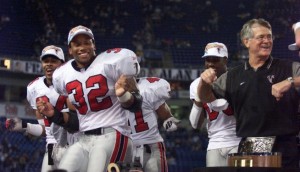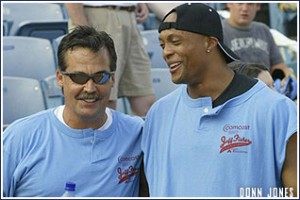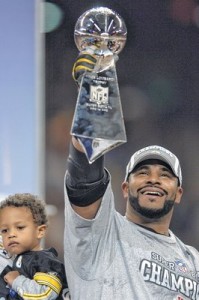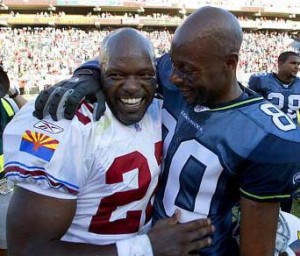Frank Gore is 29 years old and has been the featured back of the 49ers since 2006. Steven Jackson turns the same age in three weeks, and has been beaten and bruised while playing on bad teams his whole career. Michael Turner had his 30th birthday in February, and has accumulated 300 carries in three of the last four years. Fred Jackson (31) and Willis McGahee (31 in October) have had varying degrees of wear and tear during their careers, and are both competing with younger backs on their roster.
We know the wheels will fall off for these players. But do we know when? And how severe the drop-off will be? Each running back is unique, with his own genetics, history, and supporting cast. It’s difficult to find true comparisons to any one running back, let alone a group of runners. Still, we can try to identify the general aging pattern of top tier running backs.
I looked at all running backs who entered the league in 1990 or later, rushed for at least 5,000 rushing yards, averaged at least 40 rushing yards per game for their careers, and are retired. There were 36 such running backs.
Now we need a metric to measure running back productivity. Generally, I don’t think people worry about running backs failing to be factors in the passing game as they age; Kevin Faulk set a career high in receiving yards at age 32. I don’t think the focus is on touchdown production, either, and we all remember Jerome Bettis still being a short-yardage force even when he was well past his prime. No, when people discuss running backs hitting a wall and deteriorating, the focus is on declining rushing yards and rushing yards per carry. One metric I’ve used before is called “Rushing Yards Over 2.0 Yards Per Carry” or RYO2.0, for short. As the name implies, a running back gets credit for his yards gained over 2.0 yards per carry, so 300 carries for 1000 yards is worth 400 marginal yards, as is 1,060 yards on 330 carries. Essentially, we’re looking at just rushing yards with a small adjustment depending on the player’s yards per carry average.
I calculated the RYO2.0 for each of the 36 running backs at ages 22 through 34. The red line represents the average RYO2.0 for the group at each age for all 36 backs; the green line represents the average RYO2.0 only for those backs who were active in the league at that age.
As you can see, this group of running backs peaked at age 26, and had a four-year prime from ages 24 to 27. The gap between the red and green lines on the right side of the picture show that several running backs weren’t even active in the league by the time they were 30. Among all running backs (the red line), there was a very steady decline from age 26 to age 31 and then a sharper decline at age 32. Looking at just those players who remained active, they were able to mainstain steady production at age 30 and 31, before falling significantly at age 32 and being essentially done by age 34.
Those are just averages, though. Let’s look at each running back individually. I calculated the average RYO2.0 for each running back from ages 24 to 27 [1]Antowain Smith did not play at age 24 and Terry Allen did not play at age 25; for them, I simply used a three-year average excluding that season. to get a sense of their baseline production. Then I calculated their RYO2.0 at each age thereafter as a percentage of their baseline production.
| Player | Avg | 28 | 29 | 30 | 31 | 32 | 33 |
|---|---|---|---|---|---|---|---|
| Ahman Green | 816 | 0.12 | 0.65 | 0.15 | 0.18 | 0.1 | -- |
| Emmitt Smith | 809 | 0.68 | 0.86 | 0.91 | 0.76 | 0.62 | 0.58 |
| Terrell Davis | 790 | 0.16 | 0.46 | -- | -- | -- | -- |
| Shaun Alexander | 765 | 1.49 | 0.51 | 0.4 | 0 | -- | -- |
| Marshall Faulk | 731 | 1.18 | 0.72 | 0.55 | 0.53 | 0.22 | -- |
| Jerome Bettis | 688 | 0.92 | 0.9 | 0.42 | 0.46 | 0.64 | 0.22 |
| Edgerrin James | 685 | 0.71 | 0.84 | 0.36 | 0.05 | -- | -- |
| Corey Dillon | 680 | 1 | 0.39 | 1.39 | 0.46 | 0.61 | -- |
| Chris Warren | 676 | 0.66 | 0.66 | 0.26 | 0.3 | 0.22 | -- |
| Jamal Lewis | 675 | 1.05 | 0.66 | 0.32 | -- | -- | -- |
| Rudi Johnson | 668 | 0.24 | 0.13 | -- | -- | -- | -- |
| Eddie George | 663 | 0.47 | 0.72 | 0.61 | 0.25 | -- | -- |
| Clinton Portis | 624 | 0.39 | 0.19 | -- | -- | -- | -- |
| Fred Taylor | 623 | 1.13 | 0.64 | 1.1 | 1.21 | 0.43 | 0.23 |
| Curtis Martin | 616 | 1.38 | 0.93 | 1.08 | 1.55 | 0.48 | -- |
| Robert Smith | 608 | 1.53 | -- | -- | -- | -- | -- |
| Terry Allen | 608 | 1.08 | 0.5 | 0.66 | 0.64 | 0.14 | 0.53 |
| Garrison Hearst | 600 | -- | -- | 1.17 | 0.9 | 0.69 | 0.07 |
| Deuce McAllister | 591 | 0.96 | 0.07 | 0.35 | -- | -- | -- |
| Willie Parker | 577 | 0.64 | 0.33 | -- | -- | -- | -- |
| Stephen Davis | 560 | 0.73 | 1.44 | 0.08 | 0.34 | 0.17 | -- |
| Ricky Watters | 559 | 0.97 | 1.07 | 1 | 1.23 | 0.31 | -- |
| Jamal Anderson | 515 | 0.89 | 0.16 | -- | -- | -- | -- |
| Tiki Barber | 507 | 1.3 | 1.73 | 2.26 | 1.99 | -- | -- |
| Brian Westbrook | 470 | 1.65 | 1 | 0.32 | 0.4 | -- | -- |
| Rodney Hampton | 451 | 0.08 | -- | -- | -- | -- | -- |
| Travis Henry | 445 | 1.51 | 0.8 | -- | -- | -- | -- |
| Antowain Smith | 420 | 0.36 | 1.39 | 1.14 | 0.66 | 0.56 | 0.78 |
| Julius Jones | 418 | 0.74 | 0.25 | -- | -- | -- | -- |
| Adrian Murrell | 410 | 1.21 | 0.41 | 0.02 | -- | -- | 0.12 |
| Duce Staley | 393 | 0.69 | 1.13 | 0.18 | 0 | -- | -- |
| Charlie Garner | 366 | 1.71 | 1.14 | 1.63 | 0.85 | 0.14 | -- |
| Warrick Dunn | 365 | 1.16 | 1.58 | 2.34 | 1.56 | 0.73 | 1.13 |
| Priest Holmes | 296 | 3.04 | 3.34 | 2.64 | 1.69 | 0.72 | -- |
| Natrone Means | 263 | 0 | -- | -- | -- | -- | -- |
| James Stewart | 247 | 1.75 | 2.05 | 1.62 | 2.26 | -- | -- |
Let’s go through the list one by one. For lack of a better term, I’ll be categorizing the running backs by at what age they were washed up.
Washed up by the end of their age 27 season – 5 of 36 [2]One caveat: I’m using the player’s age based on his age on December 31st of the season in question. Obviously any cut-off will present some issues, as a player born in the last week of … Continue reading
Natrone Means was essentially done at age 26; he only gained 277 yards after that age. Ditto Rodney Hampton, who stopped being a productive back at age 26, averaged 3.3 yards per carry on 254 carries at 27, and then was out of the league after age 28. Rudi Johnson and Clinton Portis both fell off the cliff after their age 27 season, never to return. Terrell Davis suffered his catastrophic knee injury during his age 27 season, and was never able to regain his elite form.
Washed up by the end of their age 28 season – 6 of 36 (cumulative, 11 of 36)
Willie Parker had three good years of production from ages 25 to 27, and still averaged 72 yards per game in 11 starts at age 28. But that was it, as he permanently lost his job to Rashard Mendenhall during his age 29 season. Robert Smith retired after his age 28 year. Jamal Anderson, like Davis, suffered a brutal injury in 1999 after an outstanding ’98 season. In 2000, at age 28, Anderson was still productive, but he was finished the next season. Julius Jones was never a star, but had a productive four-year run in Dallas. During his age 28 season he showed signs of slipping, foreshadowing that he would only gain 223 more yards the rest of his career. Adrian Murrell toiled for some bad Jets teams early in his career and still gained 1,000 yards at age 28 with the Cardinals. After that, though, he averaged fewer than 3.00 yards per carry for the rest of his career. Deuce McAllister tore his ACL at age 27 but rebounded to have a very good year at age 28. More injuries limited him to just 510 rushing yards the rest of his career.
Washed up by the end of their age 29 season – 9 of 36 (20 of 36)
Shaun Alexander is a difficult one to categorize. He was so dominant at age 27 that you almost want to put him in the previous group, since he rushed for nearly 1,000 fewer yards at age 28. But he still averaged 90 rushing yards per game at age 29. At age 30, he averaged 55 yards per game and at that point it was clear that he was done; he rushed for just 24 more yards after age 30. You could say he fell off after age 28, 29, or 30 — I’ll pick the one in the middle, as it was clear after that season that his days of being elite were behind him. Travis Henry still had some productive moments in Denver, where he played at age 29; after five weeks, his 498 rushing yards was second in the league. But Henry was suspended for his age 30 season, and never played again. Ahman Green made the Pro Bowl each season from ages 24 to 27; he was injured at age 28, but still gained 1,000 yards at age 29. But he was done after that, spending two ugly years in Houston before a final send-off with the Packers (which enabled him to break the franchise rushing record). Duce Staley, Chris Warren, Jamal Lewis and Stephen Davis played pretty well at 28 and 29 years old, but their age 30 seasons saw precipitous declines. Edgerrin James saw his yards per carry drop at age 28 to just 3.4 yards per carry, but was still productive at age 29. Unfortunately for him, that was it, and he finished his career with two additional uninspiring years in the NFC West. Brian Westbrook was outstanding at ages 27 and 28, and very good at age 29. But injuries finally caught up with the smaller back, and he never again gained 500 yards from scrimmage in his career.
Washed up by the end of their age 30 season – 1 of 36 (21 of 36)
Some would argue, myself included, that Eddie George was never the same after 2000. In the calendar year — which includes week 17 of the ’99 season, four playoff games, and all of the 2000 season — George carried 519 times for 1,990 yards. He was ineffective for 315 carries at age 28, but did have a 1165 yard, 12 touchdown performance at age 29 (despite just a 3.4 YPC average). At age 30, he still topped 1,000 yards — just barely, and on 3.3 yards per rush — but that was it for George.
Washed up by the end of their age 31 season – 8 of 36 (29 of 36)

I'm not sure for who or for what, but I know for why: Ricky Watters avoided enough hits to gain 1855 yards from scrimmage at age 31.
Tiki Barber and James Stewart were extreme outliers, being significantly more productive from ages 28 to 31 than from 24 to 27. Barber retired after an excellent season at age 31, the year before the Giants would win their first Super Bowl with Eli Manning. James Stewart was injured in the pre-season during his age 32 season — when playing against a Gregg Williams-coached team — and never played again. Charlie Garner and Ricky Watters had fought father time successfully at ages 29, 30 and 31, but fell victim at age 32. Marshall Faulk, like George, had a somewhat gradual decline from greatness, and it’s difficult to pinpoint exactly when it was over for Faulk. His last dominant year was at age 28, but he wasn’t much different at age 31 than at age 29. At 31, he still was the Rams top running back, averaged four yards per carry, and gained over 1,000 yards from scrimmage in 14 games. But he rushed for just 292 yards the rest of his career.
Fred Taylor and Curtis Martin had outstanding years at age 31; Taylor made his first Pro Bowl that season and averaged 5.4 yards per carry, while Martin set a career high in rushing yards and league the league in that category. But both hit the wall after that, dropping significantly at age 32 and never coming back. Holmes had been a first-team All-Pro at ages 28, 29 and 30, and was off to his best year yet at age 31. Unfortunately, he suffered a career debilitating hip injury that season, and would never again be an elite running back. He was the victim of a brutal helmet to helmet hit during his age 32 season, but valiantly fought to stay in the league, ultimately retiring during his age 34 year.
Washed up by the end of their age 32 season – 3 of 36 (32 of 36)
Corey Dillon, Garrison Hearst and Jerome Bettis all had respectable years at age 32, but none of them contributed significantly after that. Dillon had been a solid starter for the ’06 Patriots team that made the AFC Championship Game, but chose to retire after that. Garrison Hearst had fought off a young Kevan Barlow for a couple of seasons, and remained the starter until 2003. But Hearst then went to Denver for his age 33 season, and had just 20 carries. Bettis had a bounceback season at age 32, and made the Pro Bowl, before being relegated to a part-time player for his age 33 year. Of course, he hung on for a good reason: in his final year, he won his only Super Bowl.
Washed up by the end of their age 33 season – 3 of 36 (35 of 36)
Terry Allen and Antowain Smith had their share of ups and downs, but both were still valuable contributors at age 33. Allen filled the hole left by Jamal Lewis’ knee injury for the ’01 Ravens, and led the team in rushing while averaging 3.9 yards per carry. Antowain Smith had strong years in Buffalo and New England, but he also led the 2005 Saints in rushing. At age 33, Smith averaged 4.0 yards per carry — a shade higher than his career average — and gained 659 yards on a terrible Saints team. Warrick Dunn was under-appreciated for years in both Tampa Bay and Atlanta, and most thought he was done after being released by the Falcons after his age 32 season. But Dunn led the 2008 Buccaneers in rushing yards and was tied for second on the team with 47 receptions at the age of 33, his final year in the league.
Washed up by the end of their age 34 season – 0 of 36 (35 of 36)
Washed up by the end of their age 35 season – 1 of 36 (36 of 36)
Sure, Smith was a shell of his former self by his age 35 season, but it’s hard to pinpoint exactly when he was washed up. He last was an All-Pro at age 26; his last Pro Bowl came at age 30. His last 1,000 yard season was at age 32. At age 33, he was slightly worse, and his first year in Arizona at age 34 was a disaster. But the 35-year-old Emmitt Smith averaged 62.5 yards per game for 15 games, the exact pace for a 1,000 yard season. Since the merger, only John Riggins has gained more yards at 35 or older than Smith did in 2004. With nine rushing touchdowns, his season was more than respectable. I won’t disagree with anyone who would say Smith was washed up well before he turned 35, but finding an earlier point — and being consistent with the other runners on the list — is a difficult task.
Conclusion
So what can we make of this? There is no one age when all running backs drop off, or even an age where the majority of running backs drop off. That said, by the end of their age 29 season (or, if you prefer, by the time they hit 30), half of the running backs in this study were essentially washed up. Most had gradual declines, or a down season followed by a bounce-back year and then another decline, rather than a sudden collision with a mythical wall. But at age 31 or later, 42% of the running backs had at least one solid season.
I’m not sure if we can easily characterize the group of players that powered through the mythical 30-year-old wall. Tiki Barber and Priest Holmes did not get heavy workloads early in their career, but Corey Dillon and Jerome Bettis were featured starters for essentially their entire careers. Some lesser running backs like Terry Allen and Antowain Smith were able to maintain their production late in their careers, but Emmitt Smith and Curtis Martin had big years in their thirties, too.
With the benefit of hindsight, it’s easy to see that a player fell off at a certain age, but real life doesn’t afford us that luxury. After LaDainian Tomlinson gained just 730 yards on 3.3 yards per carry his final season in San Diego, who saw him rushing for 914 yards and 4.2 yards per carry in New York at the age of 31? Ricky Williams’ career looked over, but he rushed for 1,121 yards on 4.7 yards per carry with the 2009 Dolphins at age 32. Many thought Thomas Jones was about to hit the wall when he rushed for 1,119 yards on only 3.6 yards per carry with the Jets at age 29. That wouldn’t have been an unreasonable projection, but he rushed for 2700 yards over the next seasons with a healthy 4.4 yards per carry average.
We’re always looking for the signs, and often by the time we know a running back is washed up, it’s too late. Is it clear that age is an essential component in predicting future running back performance, as players at that position decline as a group pretty consistently after the age of 26.. But just because an individual running back reaches a certain age doesn’t mean the grim reaper is around the corner. I’m not comfortable projecting two years down the line for a player who is already 30, but I don’t think it’s all that risky expecting “one more year” out of a player. I’d keep doing that until he proves me wrong, rather than trying to guess the exact year he’ll fall off and risk missing several years of strong production.
References
| ↑1 | Antowain Smith did not play at age 24 and Terry Allen did not play at age 25; for them, I simply used a three-year average excluding that season. |
|---|---|
| ↑2 | One caveat: I’m using the player’s age based on his age on December 31st of the season in question. Obviously any cut-off will present some issues, as a player born in the last week of December would be considered a year older than someone born one week later. |





